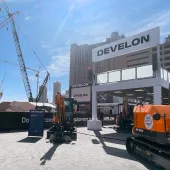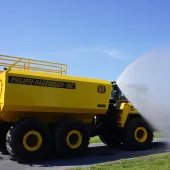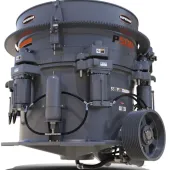DustBoss help meet military construction dust standards

Contractor uses atomized mist from DustBoss DB-30 to complete airfield apron project on time and on budget
DUSTBOSS, specialists in atomized mist technology, have helped a US government contractor to comply with strict military concrete quality and dust emission standards during the construction of an airfield apron.
By providing a consistent humidity level in a high-heat desert environment, the DustBoss DB-30 (manufactured by BossTek) helped Southwest Concrete Paving Company (SWCP) maintain the proper moisture levels needed for high-grade concrete production. In addition, the mobile misting cannon offered dust suppression during the demolition of the previous apron surface and storage of dusty material.
The result of the nine-month, multi-phase contract was a premium-quality, 72,743 square metre concrete surface that passed inspections first time while adhering to all workplace dust standards throughout the project. The consequence of not meeting the required standards can mean ripping out entire sections of the project to create a compliant product.
The life cycle of a normal road is 15–20 years, whereas the life cycle of an airstrip apron is 40–60 years. Due to the point loads of jets and other aircraft, proper curing is critical, which means engineers meticulously test for slump and moisture content every step of the way.
Paving crews in arid conditions generally work through the night to control surface temperature and slump. Critical factors include ambient temperature, concrete temperature, wind speed and humidity. As the concrete mix temperature increases, slump will decrease approximately 20mm for each 10°C rise in temperature.
‘The night temperatures fluctuated, but often remained above 27ºC,’ explained David Rath, QCQA manager for SWCP. ‘In those conditions, the relative humidity across the curing slab has to consistently stay above 40%.
‘If the surface conditions aren’t precisely controlled, the concrete surface will be prematurely exposed to tensile stresses that it cannot withstand before the hydration of the cement has passed a certain stage. This causes small cracks known as plastic shrinkage, which can significantly reduce the life of the concrete.’
Once the sun went down, the atomized misting cannon was moved to the front of the paving machine to lay an even surface of moisture across the base layer. When pouring, the moisture content of the concrete mixture is precise, but the dry ground can draw the moisture out of the mix, increasing the chances of cracking.
Due to the need for mobility, SWCP secured the DustBoss DB-30 to the back of a flatbed truck with a 946-litre water tank and a portable generator to create a completely mobile and autonomous unit, designed for conditions that lack adequate access to water and power.
The water cannon could be removed and placed on a hydraulic forklift as high as 12m in the air. This allowed improved targeting of the atomized mist sprayed over and around the newly poured concrete to provide the humidity and surface moisture needed for proper finishing.
Using the variable height and the DB-30’s adjustable 0–50° vertical angle settings, operators were able to control the humidity levels and coverage area, while compensating for wind.
Water from the tank is forced through a circular stainless steel manifold with 30 atomizing spray nozzles at the front of a heavy-duty cone-shaped barrel design. A powerful 7.5hp fan at the back of the cannon, producing 9,200 cubic feet per minute of airflow, launches millions of tiny droplets in a 30m cone.
With 180º horizontal oscillation, the unit has a coverage area of 1,580 square meters. Using only 10.6 litres/min of water, the unit raises the humidity of an entire area with evenly distributed droplets between 50–200 microns in diameter (approximately the size of fine dust), while minimizing pooling or runoff.
The unit is designed to be set up by a single worker and operated autonomously without further attention. Able to be operated by remote control, the DB-30 also has a touch-screen panel for adjusting the settings (oscillation, pump settings etc). The panel is encased in a NEMA 3R cabinet to protect it from the harmful elements of outdoor operation, such as dust, rain and contaminants.
The mobility and adjustability of the DB-30 allowed crews to reposition and recalibrate the settings of the atomized mist cannon to raise the humidity above the paved surface and prevent water from being sheared away by high winds.
‘Some of the wind conditions would have stopped construction cold in the past,’ said Mr Rath. ‘Positioning the DustBoss upwind, allowing the air to carry the humidity with it, kept us up and running on several occasions, otherwise we might have had to go back, rip out what we poured and start again.’
Wrapping up the project, core samples of the concrete taken by inspectors demonstrated high quality, with no compliance issues. Through meticulous planning, the technical skill of their staff and the use of modern technology, SWCP were able to complete the project on time and on budget with no major downtime.









